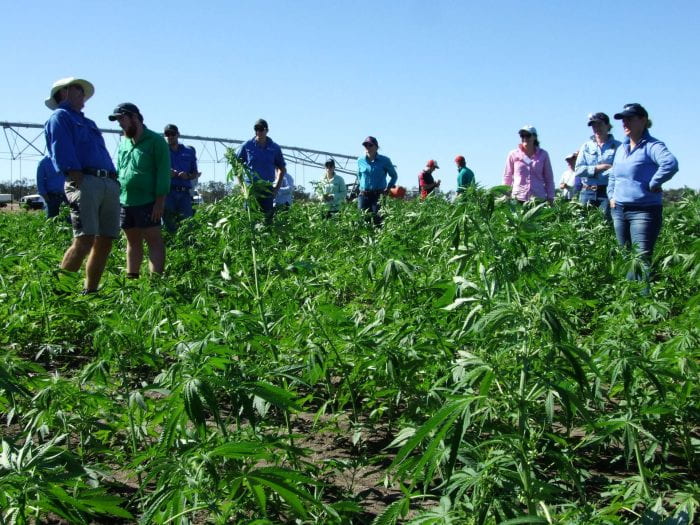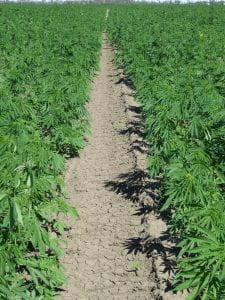Recently at the Royal Easter Show I was approached a few times by people who were determined to tell me about how wonderful hemp was. They were adamant that it made wonderful clothing and that there were ‘so many reasons as to why we should be growing hemp and not cotton’. Most of them were convinced it would use less water and therefore had to be better, but water’s not the only thing that farming is about and I was left feeling that I had to find out more.
Industrial Hemp
When I was younger I often sailed with my father and have fond memories of being shown knots and splicing with ropes made from hemp. Sadly these days most sailing ropes are of man-made fibres and aside from those days sailing I had no other notable encounters with hemp, but today cultivation of this crop is growing, both overseas and here in Australia.
The bulk of this increased cultivation is in the form of industrial hemp. The plant being grown is still Cannabis sativa, but, unlike its medicinal counterparts, the varieties grown for industrial purposes contain low (<0.3 %) amounts of tetrahydocannabinol (THC), the compound found in medicinal or recreational marijuana.
The seed from low THC hemp can be used as a food source in Australia, but the crops I have heard of to date have had other primary end uses. Most of them have been cultivated to end up in insulation materials, such as fibre board and hempcrete or to provide oil seeds for beauty products. I have yet to hear of a crop being cultivated in NSW or Queensland for the fabric market, but if interest is growing then perhaps this will change?
So as a grower I am interested, but how do I grow it?
First thing to think about is that you will need a license. To grow hemp we still need state approval and if you are irrigating, which all the hemp crops I have heard of have been, then you will also need to have an irrigation license. So it is similar in those respect to growing cotton in Australia, because we do so under a seed agreement with CSD and a technology fee from Bayer (formerly Monsanto) and if we are irrigating then we need a license.
Then there is the agronomy of the crop. Hemp is generally considered a Northern hemisphere crop, but is regularly grown in Tasmania and Victoria. It has been and is being grown in NSW and Queensland as a late summer to autumn crop that is irrigated. In theory hemp flourishes in temperatures around 15-27oC, is not frost tolerant and in an irrigated system may require between 3-6 Ml of water. On those grounds there looks like plenty of potential, but the water saving arguments I’ve been told exist seem a bit thin!
Additionally, there are reports that hemp is pest resistant. Now I hate to be a party pooper, but most of the farmers I know who have grown hemp have told me it was hammered by caterpillars, which actually is not that surprising when you look at findings from the USA and global reviews, which also highlight issues with numerous fungi. Now add into the mix that there are not any insecticidal labels in Australia with ‘Cannabis sativa (Hemp)’ on them and there is potential for all sorts of insect trouble. Some good news though is that when planted at 50-70 kg seed/ha for fibre production there are few weed issues, but for seed crops the densities are generally lower and weeds can be more problematic. Once again there are no on label options for herbicide control of weeds in hemp crops. So if you do get an insect or weed issue, are you prepared to go off label?
Harvesting your hemp
Once you have grown your crop, you have to harvest it. Hemp for fibre is often cut prior to seed setting after about 70-90 days of growth, swathed and subsequently undergoing retting. However, most of the crops I have heard of are dual purpose – seed and fibre, requiring another 30 to 40 days for seed development when they can be harvested with most modern headers.
So what’s the outlook for hemp like at present? Well, what I have been told that there is generally a lack of agronomic knowledge about this crop, that cultivation has generally thrown up one issue or another in terms of pests or nutrition and harvesting has resulted in lower yields than expected (10 kg seed/ha from one crop) as well as causing mechanical issues with combines. Certainly there is more being grown and growing interest, but the innovation that was envisaged 10 years ago has not occurred. Perhaps we will start to see more hemp being grown, but as another irrigated crop within our rotational systems and for now most of us have no water, whether from rain or irrigation sources, to grow anything. Additionally, I have not heard or found anything about growing hemp for clothing in Australia or processing the produced fibre here for a textile market. Sure you can buy hemp clothing here, but the promise of an Australian grown hemp textile industry seems unlikely.
Hard to find those many reasons
So, whilst the clothing preferences of those people at the show are hard to challenge, there are not many reasons to grow hemp over cotton that I can find. We are still talking about an irrigated crop and the water savings are not that large, although irrelevant when we have no water to start with. Pest and weed issues are likely in NSW and Queensland and there are no registered chemical control options. The hemp industry may be growing, but the supporting agronomic and industrial infrastructure is not as well developed as it could be, making product options limited and restricting potential gross margins. So for now we are better off sticking to cotton, but if you want to consider another option for your irrigated rotation then perhaps there could be a fit for hemp.
Useful resources I found when looking for more on hemp cultivation:





Hemp fibers can be grown in as little as a few months, compared to pine trees which are grown in 12-15 years. They realized they were able to help save the planet by applying the Italian hemp bedding in their barn.
Pseudo studies or pseudo investigations like this increase misinformation about Hemp . It is sad to see this online. We Will have no planet, but you Will have your cotton clothes .” So for now we are better off sticking to cotton” , love this line. Clearly you have never cultivate nothing in your entre life. Peace
Thanks for the critique Ricardo,
This ‘psedo study’ was actually an opinion piece that involved me talking to two producers who have grown hemp in the region, one agronomist who has had a couple of crops and a colleague who is heavily involved in Australian hemp production. What I wrote at the time was, and largely remains, accurate. If you have data on gross margins, water use efficiency and market growth that you want to share then please do.
As for your final comment, I have cultivated soft fruits, pome fruits, cereals, pastures, potatoes, oils seed, tomatoes, flax and cotton. To date though, I have never grown hemp, but I am willing to try anything that fits the systems I am working with.
Yours (in peace)
Oliver